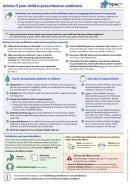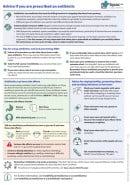Linezolid
Sounds like 'lin-ez-oh-lid'
Key points about linezolid
- Linezolid is an antibiotic used to treat serious infections that are difficult to treat with other antibiotics.
- Linezolid is also called Zyvox®.
- Find out how to take it safely and possible side effects.

Linezolid is an antibiotic which is used for serious infections that are difficult to treat with other antibiotics. It works by killing or stopping the growth of bacteria (bugs) and getting rid of the infection.
In Aotearoa New Zealand, linezolid is available as tablets, liquid and as an injection. Treatment is started in hospital, often as an infusion (an injection given slowly in a drip over 30 minutes to 2 hours). As you improve, you may be given tablets or liquid medicine to take instead of having injections.
- The usual dose of linezolid in adults is 600mg two times a day.
- Your doctor will advise you how long to take linezolid for.
- The pharmacy label on your medicine will tell you how much to take, how often to take it and any special instructions.
- Timing of your doses: Linezolid is taken 2 times a day. Try to space the doses evenly throughout the day, eg, first thing in the morning and at bedtime. Ideally these times should be at 12 hours apart. You can take linezolid with or without food. Swallow the tablets with a drink of water. Don't chew them.
- Linezolid liquid: If you've been given linezolid liquid, measure the liquid carefully with an oral syringe or measuring spoon. Gently mix the liquid by slowly turning the bottle over a few times before you use it. Don't shake the bottle.
- Missed dose: If you forget to take your dose, take it as soon as you remember. But if it's nearly time for your next dose, take the next dose at the right time. Don't take extra doses to make up for a forgotten dose. If you're not sure what to do, ask your healthcare provider. It's important to remember to take each dose on time, so set a reminder or mark your dose on a calendar so you don’t forget.
- Finish the course: Take the whole course of antibiotics for the number of days you have been told to. Don't stop taking it, even if you feel better. If you stop your treatment early, your infection could come back.
- Linezolid can react with some foods and drinks that have tyramine in them. Tyramine is in foods such as cheese, meat or yeast extracts (eg, Marmite®, Vegemite®, Oxo®), pickled fish, broad bean pods, sauerkraut, fermented soya bean products (eg, soy sauce), salami and protein drinks. Tyramine is also found in some draught beers and wine. While you are taking linezolid, avoid large amounts of any of these foods or drinks. They will cause an increase in your blood pressure and make you feel unwell.
- Linezolid can interact with many medicines, herbal supplements and rongoā Māori, so check with your doctor or pharmacist before starting any new products and let your doctor know about all of the medicines and supplements you are taking.
- It is important to tell your healthcare provider if you have diarrhoea (runny poo) during or after treatment with linezolid. Do this even if it occurs several weeks after linezolid has been stopped. Diarrhoea may be caused by a serious condition affecting your bowel and you may need urgent medical care.
- Linezolid can cause dizziness and problems with eyesight for some people, so be careful driving or operating machinery until you know how this medicine affects you.
Like all medicines, linezolid can cause side effects, although not everyone gets them. Often side effects improve as your body gets used to the new medicine.
| Side effects | What should I do? |
|---|---|
|
|
|
|
|
|
|
|
|
|
| Read more about medicines and side effects and reporting a reaction you think might be a side effect. | |
Linezolid tablet(external link), Linezolid liquid(external link), Linezolid injection(external link) New Zealand Formulary Patient Information
Zyvox(external link) Medsafe Consumer Information Sheet, NZ
References
- Linezolid(external link) New Zealand Formulary
Brochures

Advice if your child is prescribed an antibiotic
BPAC, NZ, 2024

Medicines and side effects
Healthify He Puna Waiora, NZ, 2024
Credits: Sandra Ponen, Pharmacist, Healthify He Puna Waiora. Healthify is brought to you by Health Navigator Charitable Trust.
Reviewed by: Angela Lambie, Pharmacist, Auckland
Last reviewed:






